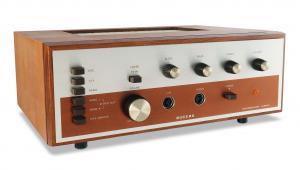Sansui AU-D33 Integrated Amplifier
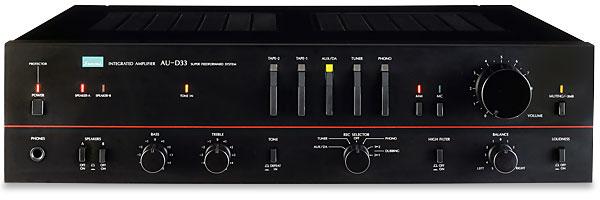
 Not only did this '80s amp claim to tackle distortion using the company's new 'Super Feedforward System', it was also priced to have mass appeal. How does it sound today?
Not only did this '80s amp claim to tackle distortion using the company's new 'Super Feedforward System', it was also priced to have mass appeal. How does it sound today?
When the Sansui AU-D33 integrated amplifier was launched in 1982, it had a lot to live up to. Its predecessor, the AU-317II from 1980 [HFN Jun '15], delivered the sort of performance one would expect from a manufacturer of specialist hi-fi, thanks to its well engineered DC-coupled circuitry. The company's 'All hi-fi, everything hi-fi' slogan set out a clear manifesto – no transistor radios, no coffee machines, just quality audio products.
Forward Thinking
The turn of the decade had not been kind to Japanese manufacturers. The revaluation of the Yen had rendered their products more expensive in key export markets, such as the UK. It was therefore necessary for designers to find ways of making equipment that cut costs without sacrificing performance, and this ushered in the use of many new technologies.
It was distortion that Sansui chose to attack with its new range of models. This was a logical step as there was little that could be added in the way of useful extra features, while power levels were already more than adequate to meet the expectations of the domestic listener. Distortion was largely an academic issue in the late 1970s. The LP and tape sources then available contributed to it far more than did any amplifier with genuine hi-fi pretensions, while loudspeakers were in many ways the bottleneck they remain today. However, distortion was a useful figure for a 'number war' – something all those marketing technical products loved at the time. The AU-317II had a rated THD figure of 0.03%, which made it all but transparent in the context of a complete system of the day. Against this, though, the AU-D33 claimed an overall figure of 0.004%, which could be sold as a near tenfold improvement.
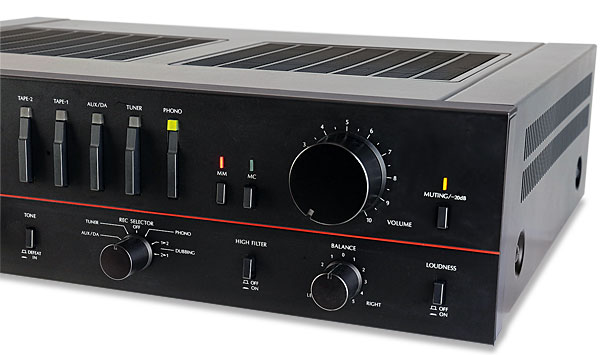
This figure did not arise from the careful revision of existing circuitry, however. Rather, a topology completely new to the Sansui range was introduced. As it added no extra controls or indicators to the amp in question, and was invisible to anyone not tempted to study circuit diagrams, a snappy name was needed to describe it. Enter the 'Super Feedforward System'.
Split The Difference
The first amplifiers to feature the Super Feedforward System were the AU-D9 and AU-D11 of 1981. They replaced the AU-D717 and AU-D919, which were well regarded but conventional designs. As with the majority of amplifier innovations of this era, the Super Feedforward System aimed to reduce distortion under dynamic conditions and not the steady-state modes of operation found only in the test lab. It worked in tandem with a normal negative feedback arrangement to ensure the amp's output stage could always drive the loudspeaker load as accurately as possible.
Negative feedback is achieved by comparing the output signal of an amplifier circuit to its input. Ignoring the effects of gain, any difference between the two can be assumed to be the result of non-linearity in the circuit – the root cause of distortion. The clever part is that by subtracting one signal from the other it is possible to largely cancel the effect, so improving the performance of the system as a whole. The problems with negative feedback come when the amplifier is asked to do too much. Large corrections, especially at high frequencies, absorb substantial amounts of power and headroom to accomplish. In a practical amp this limits the degree to which negative feedback can safely be applied.
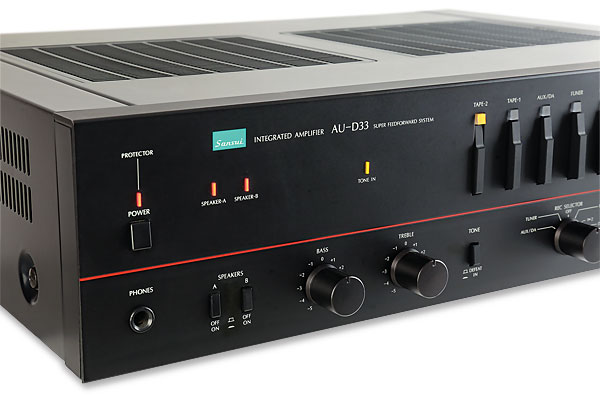
Model Behaviour
Sansui's answer was to sample the input to the hard working power stages of the amp at a point where both the programme signal and additional corrections to counteract distortion were present. A model of the amplifier's distortion could be derived by subtracting the programme signal, and this model was then inverted and amplified by what Sansui called a 'correction amplifier'. By summing the output of this with that of the main amp via a network of passive components at the complete amplifier's output, the work of driving the speakers was shared.
Furthermore, since the overall result of the two circuits working together was sent back into the negative feedback system, the requirement to make corrections fell, improving the performance yet further. The system worked best at high frequencies, so the passive summing network was engineered to favour low frequencies from the main amplifier and higher frequencies from the correction amplifier. This meant the latter did not need to be as substantial as the former, making the system as a whole reasonably cost effective to implement.
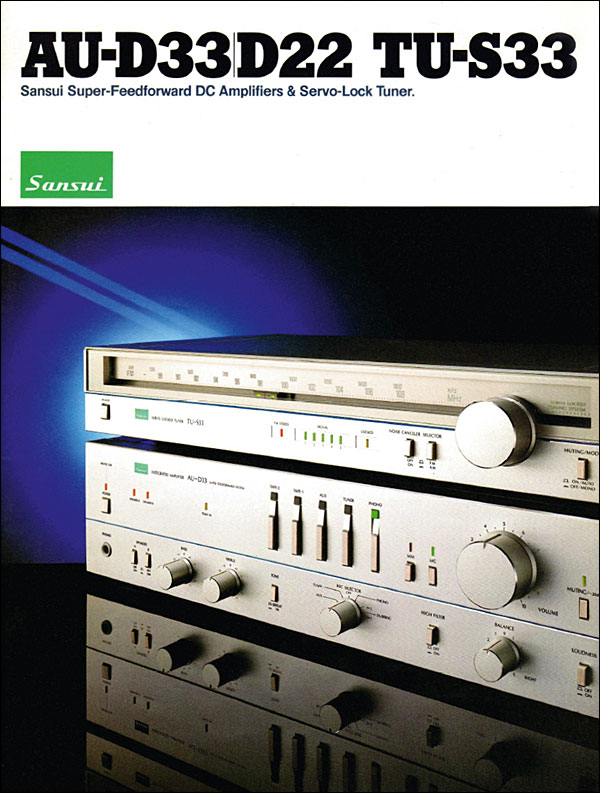
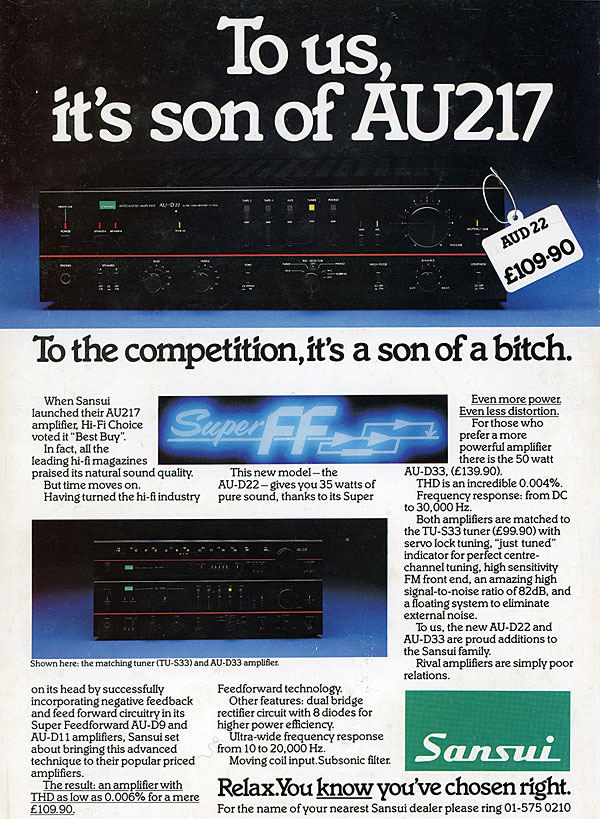
A Nod To CD
The AU-D9 and AU-D11 were large and expensive models, designed as top-of-the-range flagships for the wealthier buyer. The AU-D33 was designed to have a wider popular appeal by being smaller, simpler and cheaper. At £139 it didn't cost much more than a NAD 3020 [HFN Nov '12]. The same concepts of the Super Feedforward System remained, but to aid circuit economy the tone controls were included in the feedback loop so that they altered the main amplifier's characteristics directly.
Power was also reduced, from 120W (AU-D11) to 50W (AU-D33). This did not mean that the AU-D33 was a stripped-out, poverty-spec model, for it still retained quality features such as a built-in MM/MC phono stage and a recording output selector, which operated independently from the main input switches. Some versions even had the auxiliary input labelled 'DA' (Digital Audio) as a nod to CD.
Sensible Load
The traditional Sansui livery is black, black and more black. The AU-D33 breaks this tradition with a restrained use of colours across its fascia. Two schemes were offered – natural aluminium with a blue line or matt black with red, with most bought in the latter format. Neat LED indicators in red, yellow and green complete the effect, with quality knobs used for the major controls.
Everything one would want is there, including the facility to defeat the tone controls and limit the range of the volume control by 20dB. Loudness compensation is also available, although it is unlikely to find much use in system of well-matched components.















